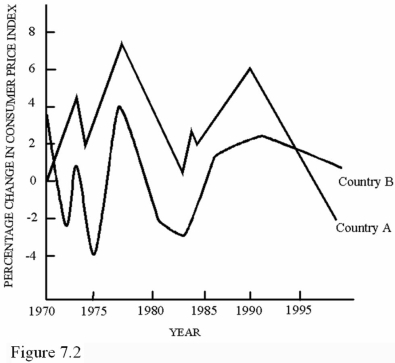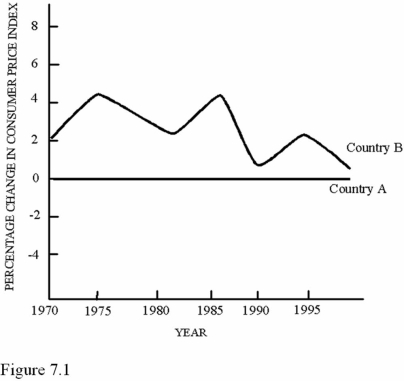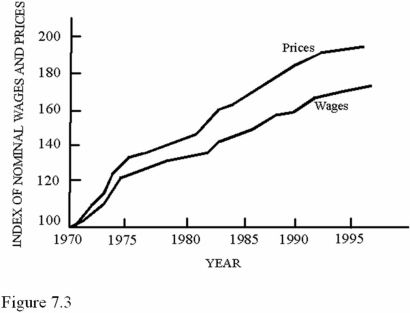A) Prices of all goods change by the same percentage.
B) Relative prices remain unchanged.
C) Average prices do not change.
D) Full employment is achieved.
Correct Answer

verified
Correct Answer
verified
Multiple Choice
If your rent increases from $1,000 to $1,100 over a period of one year and your income rises from $6,000 to $7,000,your nominal income has
A) Increased,but your real income has decreased.
B) Increased,and your real income has increased.
C) Decreased,and your real income has decreased.
D) Increased, but your real income has remained the same.
Correct Answer

verified
Correct Answer
verified
Multiple Choice
During a period of deflation,
A) The price level rises.
B) People on fixed incomes are better off.
C) People who hold cash are worse off.
D) Lenders are worse off.
Correct Answer

verified
Correct Answer
verified
Multiple Choice
Item weight is the
A) Measure of how much consumers demand a particular item.
B) Percentage of the typical consumer budget spent on the item.
C) Significance placed on a particular item by the wealthiest households.
D) Physical weight of a good or service.
Correct Answer

verified
Correct Answer
verified
Multiple Choice
 In the year 1995,which of the following statements is true about the two countries represented in Figure 7.2?
In the year 1995,which of the following statements is true about the two countries represented in Figure 7.2?
A) The countries had approximately the same rate of inflation.
B) The CPI was virtually equal in the two countries.
C) The market basket cost approximately the same in both countries.
D) Real incomes were rising at the same rate in both countries.
Correct Answer

verified
Correct Answer
verified
Multiple Choice
If deflation is 0.5 percent per year and you receive a 1 percent decrease in your salary,then your
A) Real income falls,but your nominal income remains unchanged.
B) Real and nominal income both fall.
C) Real income remains unchanged,but your nominal income rises.
D) Real and nominal income both rise.
Correct Answer

verified
Correct Answer
verified
True/False
The core inflation rate involves all price changes including food and energy.
Correct Answer

verified
Correct Answer
verified
Multiple Choice
Comparing changes in relative prices is more useful than examining average prices in
A) Determining the redistribution of income.
B) Determining the inflation rate.
C) Deflating nominal income.
D) Determining if there is deflation.
Correct Answer

verified
Correct Answer
verified
True/False
The real interest rate is the rate of inflation minus the nominal interest rate.
Correct Answer

verified
Correct Answer
verified
Multiple Choice
Which of the following reflects changes in expenditure patterns as well as price changes?
A) The CPI.
B) The PPI.
C) The GDP deflator.
D) The COLA.
Correct Answer

verified
Correct Answer
verified
Multiple Choice
Deflation is a/an ____________ in the average level of prices of goods and services.
A) increase
B) decrease
C) stagnation
D) increase followed by a decrease
Correct Answer

verified
Correct Answer
verified
Multiple Choice
Inflation rates above 10 percent rarely occur
A) In most countries today.
B) In the United States.
C) During wartime periods.
D) None of the other choices.
Correct Answer

verified
Correct Answer
verified
Multiple Choice
Use the following figure to answer the questions : Figure 7.1:  -During the time period represented in Figure 7.1,Country A
-During the time period represented in Figure 7.1,Country A
A) Experienced periods of both inflation and deflation.
B) Never achieved the inflation goal set by the Full Employment and Balanced Growth Act of 1978.
C) Had no need for COLAs.
D) Experienced only inflation.
Correct Answer

verified
Correct Answer
verified
Multiple Choice
Which of the following results from unexpected increases in the rate of inflation?
A) Decreased uncertainty.
B) Increased windfall profits to creditors who have lent large amounts of money.
C) Redistributions of income and wealth between different groups.
D) Creditors are made better off.
Correct Answer

verified
Correct Answer
verified
Multiple Choice
During a period of deflation,
A) Time horizons are longer.
B) Consumer confidence increases.
C) Lenders are better off.
D) Borrowers are better off.
Correct Answer

verified
Correct Answer
verified
Multiple Choice
Use the following figure to answer the questions : Figure 7.3 :  -During the time period represented in Figure 7.3,the purchasing power of the average worker
-During the time period represented in Figure 7.3,the purchasing power of the average worker
A) Increased because nominal wages increased.
B) Decreased because real income decreased.
C) Stay the same because COLAs probably kept purchasing power approximately constant.
D) Decreased because nominal income decreased.
Correct Answer

verified
Correct Answer
verified
Multiple Choice
The Consumer Price Index is
A) A measure of changes in the average price of all goods and services.
B) A measure of changes in the average price of consumer goods and services.
C) Used to measure the impact of business speculation on consumers.
D) The impact felt by consumers who move into a higher tax bracket because of inflation.
Correct Answer

verified
Correct Answer
verified
Multiple Choice
Generally speaking,which of the following groups would tend to gain real income from the wealth effects of inflation?
A) People with fixed income.
B) People who have passbook savings accounts at fixed rates of interest.
C) People who own assets that are appreciating faster than the inflation rate.
D) People who hold all of their assets in the form of cash.
Correct Answer

verified
Correct Answer
verified
Multiple Choice
If your nominal income remains constant at $3,000 while the price of an important product in your budget,such as cell phone service,rises from $50 to $100,your real income has
A) Decreased by $50.
B) Decreased by $100.
C) Decreased by $150.
D) Remained constant.
Correct Answer

verified
Correct Answer
verified
Multiple Choice
If consumers attempt to buy more goods than the economy can produce,the result is
A) Unemployment.
B) Demand-pull inflation.
C) Cost-push inflation.
D) The wealth effect.
Correct Answer

verified
Correct Answer
verified
Showing 81 - 100 of 106
Related Exams